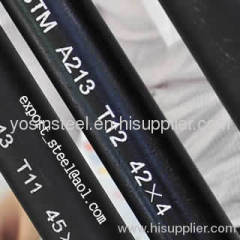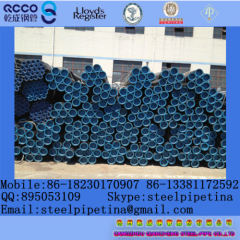
ASTM A213 T91 Seamless alloy tube
1000.0~3000.0 USD
| Min. Order: | 10 Ton |
|---|---|
| Trade Term: | CFR |
| Payment Terms: | L/C, D/P, T/T |
| Supply Ability: | 1000 tongs/year |
| Place of Origin: | Shanghai |
Company Profile
| Location: | Shanghai, China (Mainland) |
|---|---|
| Business Type: | Manufacturer, Distributor/Wholesaler |
| Main Products: | Seamless Pipe, Seamless Pipes, Alloy Steel Pipe, Pipe Fittings And Tube Sulutions |
Product Detail
| Model No.: | ASTM A213 T91 |
|---|---|
| Means of Transport: | Ocean, Land |
| Production Capacity: | 1000 tongs/year |
| Packing: | in wooden boxes |
| Delivery Date: | 30 days |
Product Description
ASTM A213 T91 Seamless alloy tube
ASTM A213 T91 Standard covers seamless ferritic and austenitic steel boiler, superheater, and heat-exchanger tubes.
Grades containing the letter H in their designation have requirements different from those of similar grades not containing the letter H.
These different requirements provide higher creep-rupture strength than normally achievable in similar grades without these different requirements. ASTM A213 T91 tubes shall be made by the seamless process and shall be either hot finished or cold finished, as specified. Grade TP347HFG shall be cold finished. Heat treatment shall be done separately and in addition to heating for hot forming. The ferritic alloy and ferritic stainless steels shall be reheated. On the other hand, austenitic stainless steel tubes shall be furnished in the heat-treated condition. Alternatively, immediately after hot forming, while the temperature of the tubes is not less than the minimum solution temperature, tubes may be individually quenched in water or rapidly cooled by other means. Tension test, hardness test, flattening test, and flaring test shall be done to each tube. Also, each tube shall be subjected to the nondestructive electric test or hydrostatic test.
Grades containing the letter H in their designation have requirements different from those of similar grades not containing the letter H.
These different requirements provide higher creep-rupture strength than normally achievable in similar grades without these different requirements. ASTM A213 T91 tubes shall be made by the seamless process and shall be either hot finished or cold finished, as specified. Grade TP347HFG shall be cold finished. Heat treatment shall be done separately and in addition to heating for hot forming. The ferritic alloy and ferritic stainless steels shall be reheated. On the other hand, austenitic stainless steel tubes shall be furnished in the heat-treated condition. Alternatively, immediately after hot forming, while the temperature of the tubes is not less than the minimum solution temperature, tubes may be individually quenched in water or rapidly cooled by other means. Tension test, hardness test, flattening test, and flaring test shall be done to each tube. Also, each tube shall be subjected to the nondestructive electric test or hydrostatic test.
ASTM A209 Through A213
- Other standard specifications include the categories of A209 seamless carbon-molybdenum alloy-steel boiler and superheater tubes; A210 seamless medium-carbon steel boiler and superheater tubes and A213 seamless ferritic and austenitic steel boiler, superheater and heat-exchanger tubes. Piping wall thicknesses range from 1/2 inch to 5 inches. A213 grades also have the letter H or M assigned, which changes the composition and specifications for that series.
This abstract is a brief summary of the referenced standard. It is informational only and not an official part of the standard; the full text of the standard itself must be referred to for its use and application. ASTM does not give any warranty express or implied or make any representation that the contents of this abstract are accurate, complete or up to date.
Chemical Composition(%) for ASTM A213 T91 Low Alloy Steel
| UNS Designation | K31545 |
| Carbon | 0.05–0.15 |
| Manganese | 0.30–0.60 |
| Phosphorus | 0.025 |
| Sulfur | 0.025 |
| Silicon | 0.50–1.00 |
| Nickel | … |
| Chromium | 2.65–3.35 |
| Molybdenum | 0.80–1.06 |
| Vanadium | … |
| Boron | … |
| Niobium | … |
| Nitrogen | … |
| Aluminum | … |
| Tungsten | … |
| Other Elements | … |
Mechanical properties for ASTM A213 T21 Low Alloy Steel
| Tensile strength(min) | 415Mpa |
| Yield strength(min) | 220Mpa |
| Elongation | 30% |
| Delivery condition | annealed |
Permitted tolerance for OD
| OD | Plus tolerance(+) | Minus tolerance (-) |
| 10.29—48.3 | 0.4 | 0.4 |
| <48.3—-≤114.3 | 0.79 | 0.79 |
| <114.3—≤219.1 | 1.59 | 0.79 |
| <219.1—≤323.9 | 2.38 | 0.79 |
| <323.9 | ±1% | |
Wall thickness is average wall or according to ASME SA530.
Notes for Bend Test:
- For pipe whose diameter exceeds NPS 25 and whose diameter to wall thickness ratio is 7.0 or less shall be subjected to the bend test instead of the flattening test.
- Other pipe whose diameter equals or exceeds NPS 10 may be given the bend test in place of the flattening test subject to the approval of the purchaser.
- The bend test specimens shall be bent at room temperature through 180 without cracking on the outside of the bent portion.
Packing:
- Packed in wooden crates, wrapped in plastic, and suitably protected for sea-worthly delivery or as requested.
- Both ends of each crate will indicate the order no., heat no., dimensions, weight and bundles or as requested.
Delivery:
Pipes are supplied in hexagonal bundles or round bundles tied with steel strip.
Weight of bundle – up to 5000 kg upon request of customer.
Each bundle is furnished with three tags.
Weight of bundle – up to 5000 kg upon request of customer.
Each bundle is furnished with three tags.
ASTM A213 Standard Scope
1.1 This specification covers seamless ferritic and austenitic steel boiler, superheater, and heat-exchanger tubes, designated Grades T91, TP304, etc. These steels are listed in Tables 1 and 2.
1.2 Grades containing the letter, H, in their designation, have requirements different from those of similar grades not containing the letter, H. These different requirements provide higher creep-rupture strength than normally achievable in similar grades without these different requirements.
1.3 The tubing sizes and thicknesses usually furnished to this specification are 1/8 in. [3.2 mm] in inside diameter to 5 in. [127 mm] in outside diameter and 0.015 to 0.500 in. [0.4 to 12.7 mm], inclusive, in minimum wall thickness or, if specified in the order, average wall thickness. Tubing having other diameters may be furnished, provided such tubes comply with all other requirements of this specification.
1.4 The values stated in either SI units or inch-pound units are to be regarded separately as standard. Within the text, the SI units are shown in brackets. The values stated in each system may not be exact equivalents; therefore, each system shall be used independently of the other. Combining values from the two systems may result in non-conformance with the standard. The inch-pound units shall apply unless the "M" designation of this specification is specified in the order.
TABLE 1 Chemical Composition Limits, %A, for Low Alloy SteelA Maximum, unless range or minimum is indicated. Where ellipses (…) appear in this table, there is no requirement, and analysis for the element need not be determined or reported.
1.2 Grades containing the letter, H, in their designation, have requirements different from those of similar grades not containing the letter, H. These different requirements provide higher creep-rupture strength than normally achievable in similar grades without these different requirements.
1.3 The tubing sizes and thicknesses usually furnished to this specification are 1/8 in. [3.2 mm] in inside diameter to 5 in. [127 mm] in outside diameter and 0.015 to 0.500 in. [0.4 to 12.7 mm], inclusive, in minimum wall thickness or, if specified in the order, average wall thickness. Tubing having other diameters may be furnished, provided such tubes comply with all other requirements of this specification.
1.4 The values stated in either SI units or inch-pound units are to be regarded separately as standard. Within the text, the SI units are shown in brackets. The values stated in each system may not be exact equivalents; therefore, each system shall be used independently of the other. Combining values from the two systems may result in non-conformance with the standard. The inch-pound units shall apply unless the "M" designation of this specification is specified in the order.
TABLE 1 Chemical Composition Limits, %A, for Low Alloy SteelA Maximum, unless range or minimum is indicated. Where ellipses (…) appear in this table, there is no requirement, and analysis for the element need not be determined or reported.
B It is permissible to order T2 and T12 with a sulfur content of 0.045 max. See 16.3.
C Alternatively, in lieu of this ratio minimum, the material shall have a minimum hardness of 275 HV in the hardened condition, defined as after austenitizing and cooling to room temperature but prior to tempering. Hardness testing shall be performed at mid-thickness of the product. Hardness test frequency shall be two samples of product per heat treatment lot and the hardness testing results shall be reported on the material test report.
alloy steel, ASTM A213, ASTM A213 T91, Seamless alloy tube, steel tubes, superheater tubes, t91, Tubing







